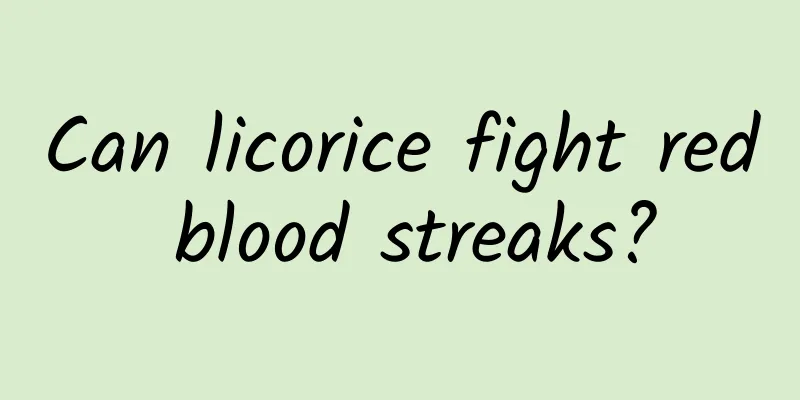Can licorice fight red blood streaks?

|
Licorice is a kind of plant Chinese medicine and is widely used in traditional Chinese medicine. The medicinal value of licorice is very high. After taking it, it can treat the disease and also relieve pain and cough. Licorice is a kind of qi-invigorating medicine and has no effect on treating red blood streaks. Other methods can be used to treat red blood streaks, or anti-blood streak skin care products can be applied. Can licorice fight red blood streaks? Licorice can replenish qi and strengthen the middle; relieve acute and acute pain; moisten the lungs and relieve cough; purge fire and detoxify; and harmonize various medicines. It is mainly used for fatigue, loss of appetite, thin skin and yellow face, palpitations and shortness of breath, abdominal pain and loose stools, cramps and pain in the limbs, irritability, cough and asthma, sore throat, sore carbuncle, fetal toxicity in children, and drug and food poisoning, but it does not eliminate red blood streaks. Effects 1. Clear away heat and detoxify When used raw, licorice can calm the qi and relieve heart fire, so it has the effect of clearing away heat and detoxifying. Modern medicine has confirmed that licorice does have a good detoxification function. 2. Expectorant and cough relieving Licorice flavonoids, licorice extract and glycyrrhizic acid all have obvious antitussive effects; the expectorant effect is also significant, and the intensity of their effects is glycyrrhizic acid > glycyrrhizic flavonoids > licorice extract. 3. Acid resistance Licorice has an effect similar to adrenal cortex hormone. It has an inhibitory effect on excessive gastric acid secretion caused by histamine; it also has antacid and gastrointestinal smooth muscle spasm-relieving effects. 4. Anti-inflammatory and anti-allergic Licorice also has anti-inflammatory and anti-allergic effects, and can protect inflamed throat and tracheal mucosa. Licorice extract and glycyrrhizic acid have a detoxifying effect similar to glucuronic acid on certain poisons. 5. Regulate hormone secretion Licorice contains isoflavones, which means it can have estrogenic and/or anti-estrogenic effects. As a result, this herb is thought to help regulate endocrine function and reduce PMS and menopausal symptoms. 6. Prevent and treat tumors The subcitonic acid contained in licorice can block the effect of carcinogens in inducing tumor growth. Nutritional Value Licorice is the root and rhizome of the perennial herb licorice. It is sweet and mild in nature, and enters the heart, lung, spleen, and stomach meridians. It has the functions of nourishing the spleen and replenishing qi, moistening the lungs and relieving cough, relieving acute pain and alleviating medicinal properties. Its active ingredients are glycyrrhizin, glycyrrhetinic acid, glycyrrhizin, and licorice polysaccharides. It is one of the commonly used Chinese herbal medicines in clinical practice. 1. Licorice is warm in nature and has the effects of clearing away heat and relieving heat and toxins. It is effective in treating poisonous diseases and symptoms such as pain, swelling, and carbuncle. 2. Licorice powder, licorice extract, glycyrrhizin and glycyrrhetinic acid all have deoxycorticosterone-like effects, which can reduce urine and sodium excretion and increase potassium excretion in healthy humans and a variety of animals. 3. Glycyrrhizic acid has an inhibitory effect on cotton ball granuloma, formaldehyde edema, tuberculin reaction, and subcutaneous granuloma cystic inflammation in rats. Glycyrrhizinamide and sodium glycyrrhizinate can effectively affect the exudative and proliferative phases of subcutaneous granulomatous inflammation, and their anti-inflammatory strength is weaker than or close to that of cortisone. 4. Glycyrrhizin can directly destroy viral cells in test tubes and also has an inhibitory effect on varicella and herpes zoster viruses. In addition to its direct effect on viral particles, the antiviral effect of glycyrrhizin is also related to its induction of interferon and increase in natural killer cell activity. 5. After oral administration, licorice can cover the inflamed pharyngeal mucosa, relieve inflammatory stimulation and suppress cough. At the same time, licorice can promote the secretion of pharyngeal and bronchial mucosa, making phlegm easier to cough up, thus exerting an antitussive and expectorant effect. |
>>: Can Kuding reduce inflammation?
Recommend
The efficacy and function of neem leaves
Traditional Chinese medicine often has unexpected...
If you love running, you must read this! How to protect your knees during long-term running?
Speaking of running, as someone who has been runn...
The efficacy and function of Feilian [picture]
Fei Lian [picture] is a very common Chinese medic...
The efficacy and function of Asarum
Asarum is a traditional Chinese medicine. In addi...
World's first! Submarine-launched hypersonic weapon test-fired, Russia announces successful test-fire of Zircon by nuclear submarine
Some time ago, the Russian Ministry of Defense an...
Bee: I love to pick the sweetest wildflowers on the roadside.
I am Dong Dong Meow Talking animals are so fun! T...
What are the medicinal values of Artemisia selengensis sprouts?
Artemisia selengensis sprouts are a common Chines...
Stop eating lard to prevent cardiovascular disease! Here are 6 things you should do
According to statistics, there are 330 million pa...
The efficacy and function of Jiujunliang leaves
Nowadays, our living standards are constantly imp...
The efficacy and function of rapeseed
Many people are not very clear about the effects ...
Who is not suitable to eat Cassia seeds?
Cassia seed is a common Chinese medicine in daily...
What are the effects and functions of Niu Teng?
Few people would cook or eat Achyranthes bidentat...
The efficacy and function of cinnamon wood
I don’t know if you are familiar with osmanthus w...
Ten-flavor frankincense capsules
Probably not many people know what this medicine ...
What are the effects and dosage of Poria cocos?
Poria cocos has always been a medicinal material ...




![Effects and functions of borneol seeds[picture]](/upload/images/67ca407647fd4.webp)




